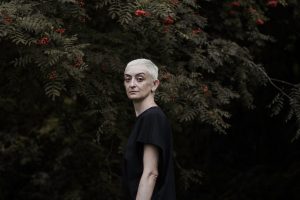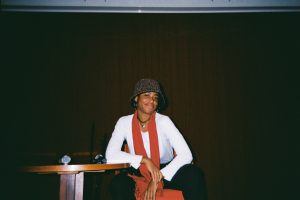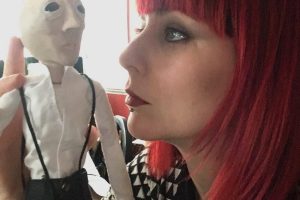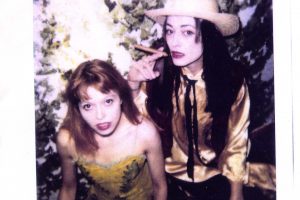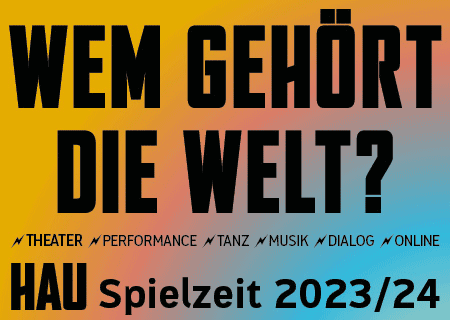Lyndelle-Jayne Spruyt (L.J.Spruyt): “I’ve often been told my work is very ‘dark’, I’m not sure this is true”
I met Lyndelle in Tasmania when I was there performing with my project hackedepicciotto at the Dark Mofo festival. I had became friends with her on facebook through her husband JP Shilo whom I had met touring with Mick Harvey. She seemed extraordinarily interesting and I was very curious to meet her in real life – there is always a hit or miss chance in getting to know a facebook friend and in this case it was a true pleasure.
I have always admired people that turn every aspect of their lives into objects of beauty. It reveals a deep appreciation and respect for details, which has become rare in our industrialized, plastic world of fake news and overflowing garbage. Lyndelle seems to stem from a different universe altogether. She was born in Australia but grew up in Japan. Her grandmother was French and so quickly she was trilingual and gifted with the elegant grace these various cultures have mastered.
We could not spend much time together but kept in touch and over the years I was delighted by the beautiful film and photographic work she has created for diverse bands and projects. Her magical touch, turning surroundings into mesmerizing universes, translates into her work, which has depth and shadows as much as beauty. Her colors are rich or black and white, but even they are rich and
reminiscent of the Film Noir era. This is the nutrition I often crave for after looking at flat Netflick aberrations or despondently leaving a Gallery after having seen yet another interchangeable I- phone exhibition. Quality is a virtue I seem to need more of every day and Lyndelle- Jayne Spruyt is a wonderful oasis that quenches this thirst. I am very happy to introduce her to you here today.
Danielle de Picciotto: Are you a self-made photographer and filmmaker, or did you study these professions?
L.J.Spruyt: I’m a trained multi-disciplined Fine-Artist and that shapes my aesthetic, yet I would qualify more as a self taught photographer, and especially film maker; as even though my studies in the early 90’s involved photography, I placed my focus on painting. At the time, photography was analogue, which really insisted a very different approach, compared to the digital format. As a student, I tended to take advantage of the facilities’ darkroom and developing equipment to manipulate the format, mostly through experimentation, and never really fulfilled the requirements of any set ‘assignments’, disregarding the course curriculum (much to my lecturers chagrin, and the audacity of youth- I’m pretty sure I was ‘failed’ on that subject). In that regard, I would refer to myself as a self-taught photographer- real learning and artistic practice via self-determination/teaching, only came later in life.
While I was studying, I was still focused on painting, mostly working in oils (when I could afford it), and experimental drawing/collage using any materials at hand, but also those that I had picked up from art school, like working with bitumen, shellac, shoe polish with glue and cutting back with knives etc. I loved the physical immediacy of these mediums and the energetic results. These physical ideals also worked themselves into the experimental nature of my analogue photography at the time.
It was over a decade later, after the birth of my second daughter, that photography took a forefront to my artistic practice – juggling babies and turpentine wasn’t working for me. Not being able to afford ‘studio space’ or ‘time’ to separate the two roles in my life, insisted I found myself having to work differently. My energies shifted (as can often happen with a young child), and I became less inclined to even draw. I started taking photos. For every photo I took, I would name it, and would always classify them as ‘paintings yet to be painted or ‘unpainted painting 1..2..3…idem’. It was only when I realized that the photographs themselves had had merit, that I was able to shift my thinking and my process towards photography; giving it the time and acknowledging the photos with the respect I would a painting. At that point, I became a ‘photographer’.
As a filmmaker, I am completely self-taught, conversely, as the digital format lent itself naturally to move on to the next possibility within the one apparatus- the moving image.
You work a lot in black and white, – what do you like about this style specifically? Do you prefer it to color?
I think working predominantly in black and white also came from my painting practice. As a painter, I was always intrigued by the depths of tones you could create within what might simply be perceived as the use of ‘black paint and white paint to distinguish all the grey in between. When I had a better understanding that it required color, to build black, that black itself embodied the use of every couloir, and the colors themselves were required to create tonal shifts as simple as warm or cold. With black and white, there is everything in-between. Not just black, white and grey.
Sebastiäo Selgado specifically is an example of a photographer who achieved iconic tonal differentiation with his black and white photography, and whose work I greatly admire. Henri Cartier Bresson is another photographer whose black and white photography greatly resonates with me, as well as
Dorothea Lange. All three photographers have perfectly captured ‘humanity’ and something of ‘the human condition with vastly different story telling.
Black and white photography (for me) affords the eye to focus more on contrasts, and depths, something soulful and sometimes timeless is rendered- like reading a book before viewing a film, you paint the colors of the story behind the picture in your mind, you are drawn in- you as the photographer can be telling a story, while leaving the viewer to draw their own emotion or response sensation to what might seem stark in comparison to a color photograph. (this is true of any art form really, but I find it specific to black and white photography).
It’s difficult to qualify whether I prefer black and white photography to color. It will often be the subject that will dictate whether a photograph needs to be expressed in B+W or color, but what I’ve always understood about my photography, or the desired effect I’ve worked to achieve- is drawing light out of the darkness (the definition of photography itself ‘light drawing’).
Whether the form that finds itself drawn from its black surrounds is black and white, or color; I think I generally work with the same desired outcome.
I personally refer to it as a “caravagesque” (of Caravaggio) effect. That any subject, no matter how light, or dark, how shallow or deep, disturbing or inspiring- I seek to draw beauty into/out of all imagery, even the things people might find most ugly, there is always beauty within.
I’ve often been told my work is very ‘dark’, I’m not sure this is true, or how I would read it or feel it, but if that is how it’s ‘perceived’,
it can only be left to the viewer.
Do you have specific topics that you are mainly attracted to or does it vary from commission to commission.
Topics tend to vary from commission to commission, but I think I’ve been fortunate that most of my client base is attracted to certain elements of my work, hoping to achieve a feel or sensation for their pieces, that resonate with my imagery, and that can bring something to their storytelling, dynamic or style.
This can have a very positive symbiotic affect.
Each commission is different, and inevitably the work that gets produced will vary according to budget constraints and the clients brief. It all involves a certain trust to create an effective synergy.
My underlying interest, whether in photography or cinematography is the human condition. Revealing or rendering this is something that doesn’t require a distinct format, it is everywhere, it surrounds us in others, is within ourselves, and the landscapes we live in or travel through- as well as the politics we are subjected to, that define our past, affect our future, and how we relate to each other. A modern reflection of that would be Tony Gatlifs work.
I find it difficult to pigeonhole a preference of ‘subject’, or format that we use to classify certain types of photography–to me the edges are blurred, and meld into each other, as inevitably do the topics I’m interested in. I do specifically like working with portraiture. Portraiture is something that can lend itself to dreamscapes and soul scapes, many and varied entities within, that as much as you can capture a ‘portrait- this in itself can be a ‘landscape’ or a ‘still life’ depending on how you render the subject, or what the subject reveals to you.
Some people have great ease in front of the camera, but I find a lot of the time (like myself), many don’t- and it’s that trust that you create through the style of your direction that puts someone at ease, and allows them to feel comfortable revealing themselves- that certain something that makes them; them.
I’m intrigued by photo journalism as a genre that evokes ‘the human condition’, but can also be left uncomfortable when I feel, or it shows that a photographer has taken advantage of someone, or a circumstance for personal gain- regardless, of it ‘exposing’ something to the world that we need to be shown. It’s a difficult line, some navigate it very well with great respect, and it’s something I’d like to delve into.
Topic wise, anything and everything is a photo when I see it. Inside or out, faces and forms smile or poke their tongues at me in every fold of fabric, shadow, cloud or tree I see.
Landscape photography/cinematography is an inevitable joy, or something you can find yourself a slave to, with nature’s ever changing tones, formations and contrasts- I am constantly ‘chasing light’, and all its tonal shifts between the silver hour to the golden hour, and the darkness beyond.
These lighting shifts inevitably create such a varied scope of sensations, even if photographing just the one object- depending on the light cast upon it- the mood, the emotion or the sensation of that one object/ scape will vary.
I want to capture everything! It doesn’t take long as a photographer/cinematographer to not be able to leave the house without a camera, or feel naked somehow if you do.
What do you think of digital photography in comparison to the good old film roll and developing photos yourself in the darkroom?Ah, the answer almost lies within the question–yes, the ‘good old film days’. It’s almost as if they are completely different mediums, the process arrives at a similar result, but the process of analog is now almost ritualistic, I have a nostalgia and reverence for the photography of old. There was/is something undeniably satisfying about the physical sensation of pressing the shutter button, the auditory satisfaction, a sense of completion sounded off by the ‘click’, and the action sound of rolling the film forward to your next chance capture. That’s what it was, chance. Chance and skill.
The chance that you captured that one moment, and that you had the skill required to work your camera to it’s best abilities according to your what is now, comparatively limited ‘settings’. It required a different kind of precision, or just plain ‘luck’. Sometimes that luck was a double or triple exposure that gave you a surreal image beyond any affectation you could have attempted to achieve. You also couldn’t afford to buy endless rolls of film, paper and chemicals–so the photos you took, had to count!
The developing and printing process required a much more physical/ hands on approach availing itself to various manipulations- scratching, drawing, (acid) burning into the negatives or prints themselves, which lent towards a more visceral feel. The ‘edit’ process and experimentation of ‘post’, was in the darkroom. How long you left your exposures, what kind of contrasts/darkness/depths you achieved, depending on how you treated the paper in the chemical baths.
I think as an outcome, my photography at the time went further to take on 3d aspects, using negatives, slides and plates themselves to create layered and built objects; almost like a ‘trompe l’œil’ affect in physical form, as well as collage.
The shift to digital photography has been a difficult one (I’m not great with tech), but at the same time- extraordinarily rewarding. Working digitally has availed me towards a more cinematographical realm than I initially would have imagined. Even though I muddle through the technology side of its function, and the programs I’m required to work with- the possibilities the digital format allows, for the moment seem endless.
The evident comparisons are being able to take an endless amount of shots, and work through trial and error immediately within the camera, although you learn quite quickly to take less shots, and create less work for yourself in post by having endless choice! They really are two different mediums.
Silver nitrate vs. ones and zeros.
Is moving film a reel of photos for you or do you see photography and film making as two separate entities?
There is something fascinating about viewing single frames of a film, like Eadweard Muybridge’s series depicting moments in movement. As a cinematographer I try to pay that much attention to my work, each frame should/could be a still. But as a filmmaker I concentrate on imbuing the overall collection of frames with a story. As a still photographer I aim to trigger an entire film in the viewer. The most fascinating moving films to me sometimes are almost static, and reveal the stillness in time. That tension of no movement. And some of the most fascinating still photos are captured movement, the frozen blur. The stillness of motion.
Then we have films like La Jetee or even Warhol experiments that mess with that.
What is required of you with photography, but more specifically cinematography, has forced me to find my directorial voice. I’m a naturally shy and softly spoken person, so having to elevate my voice to direct effectively, also elevated my own understanding that I managed to quite quickly develop a confidence and skill in directing, that creates trust and confidence with the client. What feels good on set shows in the work of both disciplines. Sometimes a client may have a clear notion of what they want to achieve, and sometimes they’ll require the whole picture to be painted, and place trust in you to do that. This can be the same for both photography, and filmmaking Trust and confidence become key elements to drawing the best out of your subject, as equivalently as trusting my directorial style.
The reality (or nature) of being a female director, has shown it’s own set of hurdles, and definitely taught me a lot about human nature outside of normal socially based relationships. Yet very differently of course, when working purely on my own projects, the sensibility of capturing a photograph, or filming a scene, feel very similar–and I often wish I could do both at once. To that end, if I have an idea formulated, I’ll do exactly that, I’ll set up so I can both film and photograph simultaneously.
The profession as a film maker/photographer is behind the lens, your husband whom you accompany on many tours is a musician is in front of the lens. Do these different positions inspire you? What artists inspire you?
As a photographer, I am extremely uncomfortable in front of the lens. When I’m doing live music photography, my aim is to always showcase the beauty and strengths of a performer. I see beauty in all things, no matter how uncomfortable a sense of ‘beauty’ can be, my desire is to reveal it.
Capturing an artist’s signature style, through my own. That is very important to me, for a photo of an artist/performer to be successful, it must enhance them, otherwise- you’re pissing in the wind. There are so many considerations when photographing musicians in their element, in a crowd/stage situation. As mentioned above, I always seek to capture the essence of the artist in a way that lets the viewer feel that they are in the room, and can ‘hear’ the music being performed.
A lot of elements can contribute to this outcome–the artists expression, the way they hold their instrument and their body while performing, (their gestures, facial and physical) and whatever the lighting on stage affords. Unfortunately, some of these best moments are during the more ‘silent’ movements of a piece, and when as a (considerate?) photographer, you make the painful decision not to ‘click’ during these moments and forego the shot–I don’t want to be that photographer that breaks the spell/ambience an artist has woven, by the evident or constant ‘clicking’ sound of a camera.
So sometimes I miss out on what might be the most deliciously expressive photographic moments on stage.
Of course live ‘action’ and movement at a crescendo of noise and expression is also a great time to shoot–it varies, if you can achieve both with respect to the artist and the audience, you’ve done well.
The artists that inspire me have inevitably informed my work. There are what I’d consider grand masters that form a basis of inspiration, painters like Hieronymus Bosch, Caravaggio, and Schiele, film directors like Agnes Varda and Chantal Ackerman, amongst many others of course, and photographers like Joel Peter Witkin covered in other questions. In reality though, I’m speaking only of staples, as art and artists are continually evolving and surfacing, to try and count or categorize them all (thankfully) would be a huge task- there is so much great work out there, inspiring and informing.
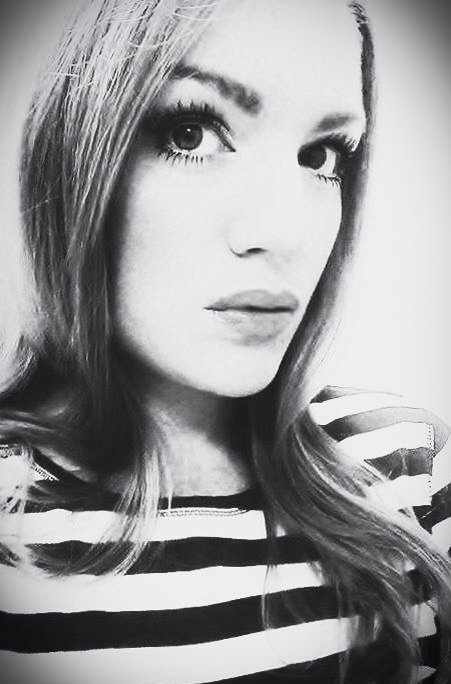
What is your take on selfies?
It’s a question that requires a many pronged answer, because I think, like the word ‘cancer’ (of which there are so many forms)–the use of the word ‘selfies’ has become an ‘umbrella’ term, that covers a lot of different artistic principles and practices, behaviors moral/immoral, simplistic or narcissistic- depending on how you define, or reference the term.
The immediate French translation of a ‘selfie’, is ‘auto portrait’, and when thinking semantically (in English), I can’t help preferring to reference a ‘selfie’ as an ‘auto portrait’. It’s a reminder that since humankind has had the ability to portray or paint themselves upon a surface, however ephemeral- we go right back to the days of cave man and ‘hand prints’ on a wall.
The first known painted ‘self portrait’ (Portrait of Man in Turban, by Jan Van Eyck) dates back to 1433, with many great (and many unknown) painters (as the only medium at hand) using themselves as a model, or representation in a work of art.
Following on to the better known works of Van Gogh, and of course the inimitable Frida Kahlo. Artists throughout time have used themselves as a model to either represent an immediate moment in time, tell a story about their lives, make a political statement- or very simply, be the only person at hand to work with.
Symbolism of various forms carries through these artists works, almost comparatively (or unfortunately) to how certain selfies today use the symbol of a product, or something about themselves, they are trying to ‘sell’.
The first auto portraits in the world of photography came from the Daguerreotype, by Robert Cornelier in the 1830’s. Basically, ever since humankind has had the ability to represent themselves, whatever the medium–auto portraits/selfies have been a part of artistic practice.
Photographers like Cindy Sherman ( an artist who used herself to great effect, creating characters of all kinds to set the stage of what might be a ‘film still’ or a ‘moment in the life of ~~~ using herself and her skills of transformation to achieve these projects.)
Man Ray, Andy Warhol, Richard Avendon, Robert Maplethorpe are all artists that have used themselves as the ‘protagonist’ of their work -taking ‘auto portraits’, or as we’d call them now-‘selfies’. The recently discovered works of Vivian Maier–someone who’s work via many self portraits–shows us a representation of the times, her self portraits taken in reflections of shop windows, or train carriages- almost a winsome sense of self but definitely a ‘reflection’. A major contrast to todays ‘selfie’ culture, that I don’t have the same respect for, and find quite disturbing.
Photo booths were almost the first form of selfie–something to give to a friend, send to a loved one- something to mark an event, time or place, with ‘yourself’ in the picture. I use the auto portrait often, to reflect a moment of joy, even sadness, celebrate a time, reference places I’ve been, people I love, but artistically, I am often my best model (I only have to argue with myself), and can create any kind of image symbolic or artist as if I’d painted it.
Unfortunately nowadays the “selfie” is regarded in a derogatory way, and in the hands of some it is. Pure self-aggrandizing/advertising/objectifying. It is a fine line, but to the discerning eye, we know when one is a vanity project, striving to sell something of the self, or in todays world of ‘influencers’-just sell something; that I find a very sad thing. It’s something I worry about for my daughters (and most people young or old, male or female) having to navigate the maelstrom of imagery in these times, under the scrutiny and judgment of social media, and feel in any way, that they have to ‘keep up’.
What are you working on momentarily?
At the moment I’m working on a piece commissioned by The City of Melbourne. It has varied aspects, as cinematically, it involves two completely different approaches, taking a 4.5 min clip out of a 35 min piece as a ‘film clip’, then making a film, for the entirety of the piece = two completely different visuals.
The situation we find ourselves in internationally with covid19, and the backdrop of the BLM movement has placed many question marks as to how the visuals of this piece might be represented, as the piece itself has an uncanny premonitory feel to it, and many correlations that were at the time; unintended. Covid has meant that it’s not been possible to step out singularly or with a crew, and film as you might ordinarily. To work around that, I’ve had to change my initial ideas/scope for the work, and allow the visual storyline to take on a different and more surreal approach using various stock footages from my catalogue, and collaborating with a marine cinematographer, which is quite exciting, and hopefully- will be very evocative. to the narrative.
What are your plans for the future?
Continuing to cultivate my work across a few artistic endeavors/disciplines- cinematographic, photographic and welcoming new commissions and collaborations along with continuing process my own personal projects. If we’re being shown ‘anything’ about the nature of ‘everything’ that is going on in this year 2020, we are learning that there is no certainty to anything, and are having to adapt- in the way we work, live and basically function.
I’m looking forward to taking some time to refine my skills, and focus on projects, that I won’t describe for the moment, but am ultimately working towards a solo exhibition.

















